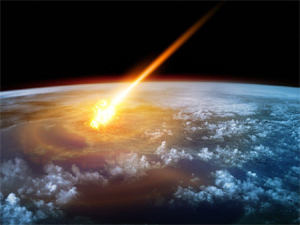



Date:21/12/16
 The Russian Center for Planetary Protection has developed a system to protect the Earth from killer asteroids with the help of nuclear blasts, which will cost $5.6 billion, Center CEO Anatoly Zaitsev said on Tuesday.
The Russian Center for Planetary Protection has developed a system to protect the Earth from killer asteroids with the help of nuclear blasts, which will cost $5.6 billion, Center CEO Anatoly Zaitsev said on Tuesday.
The center’s chief executive made the project’s presentation at the 2nd scientific and technical conference of the Extra-Departmental Expert Council on the issues of the aerospace sphere.
According to the presentation, the system can be created within five to seven years. It should consist of surveillance satellites, space observatories, interceptors and the ground-based control and surveillance segment.
At the first stage, four space vehicles are intended to be launched: two surveillance spacecraft and two asteroid interceptors. This stage is estimated at $1.3 billion. The creation of the ground infrastructure is estimated at another $1 billion, according to the presentation.
If a dangerous asteroid is revealed, a surveillance satellite is expected to be sent towards it to specify the trajectory, the celestial body’s size, weight and other characteristics. After that, a space vehicle will be sent to detonate a nuclear charge near the asteroid either to destroy it or make it deviate from the trajectory of its flight towards the Earth.
The development of the space surveillance segment, which envisages the launch of two observatory satellites and four surveillance space vehicles will cost another $1.4 billion, according to the presentation.
Simultaneously, the project proposes increasing the number of interceptor satellites by another three space vehicles, which is estimated at $1.8 billion.
The Center for Planetary Protection was established in 2002 as a non-profit partnership of the Babakin Research and Production Center (a subsidiary of the Lavochkin R&D Enterprise). The Center is developing a concept of the system of planetary protection from asteroids and comets and possible scenarios of space threats and the methods of their prevention.
Developer says project to save Earth from asteroids with nuclear blast to cost $5.6 bln
 The Russian Center for Planetary Protection has developed a system to protect the Earth from killer asteroids with the help of nuclear blasts, which will cost $5.6 billion, Center CEO Anatoly Zaitsev said on Tuesday.
The Russian Center for Planetary Protection has developed a system to protect the Earth from killer asteroids with the help of nuclear blasts, which will cost $5.6 billion, Center CEO Anatoly Zaitsev said on Tuesday.The center’s chief executive made the project’s presentation at the 2nd scientific and technical conference of the Extra-Departmental Expert Council on the issues of the aerospace sphere.
According to the presentation, the system can be created within five to seven years. It should consist of surveillance satellites, space observatories, interceptors and the ground-based control and surveillance segment.
At the first stage, four space vehicles are intended to be launched: two surveillance spacecraft and two asteroid interceptors. This stage is estimated at $1.3 billion. The creation of the ground infrastructure is estimated at another $1 billion, according to the presentation.
If a dangerous asteroid is revealed, a surveillance satellite is expected to be sent towards it to specify the trajectory, the celestial body’s size, weight and other characteristics. After that, a space vehicle will be sent to detonate a nuclear charge near the asteroid either to destroy it or make it deviate from the trajectory of its flight towards the Earth.
The development of the space surveillance segment, which envisages the launch of two observatory satellites and four surveillance space vehicles will cost another $1.4 billion, according to the presentation.
Simultaneously, the project proposes increasing the number of interceptor satellites by another three space vehicles, which is estimated at $1.8 billion.
The Center for Planetary Protection was established in 2002 as a non-profit partnership of the Babakin Research and Production Center (a subsidiary of the Lavochkin R&D Enterprise). The Center is developing a concept of the system of planetary protection from asteroids and comets and possible scenarios of space threats and the methods of their prevention.
Views: 475
©ictnews.az. All rights reserved.Similar news
- Azerbaijani project to monitor disease via mobile phones
- Innovative educational system to be improved under presidential decree
- NTRC prolongs license of two TV and radio organizations for 6 years
- Azerbaijan establishes e-registry for medicines
- Azerbaijani museum introduces e-guide
- Nar Mobile opens “Nar Dunyasi” sales and service center in Siyazan city
- International conference on custom electronic services held in Baku
- OIC secretary general to attend COMSTECH meeting in Baku
- Azerbaijan develops earthquake warning system
- New law to regulate transition to digital broadcasting in Azerbaijan
- Azerbaijani State Social Protection Fund introduces electronic digital signature
- Intellectual traffic management system in Baku to be commissioned in December
- Tax Ministry of Azerbaijan started receiving video-addresses
- World Bank recommends Azerbaijan to speed up e-service introduction in real estate
- Azerbaijan to shift to electronic registration of real estate





















